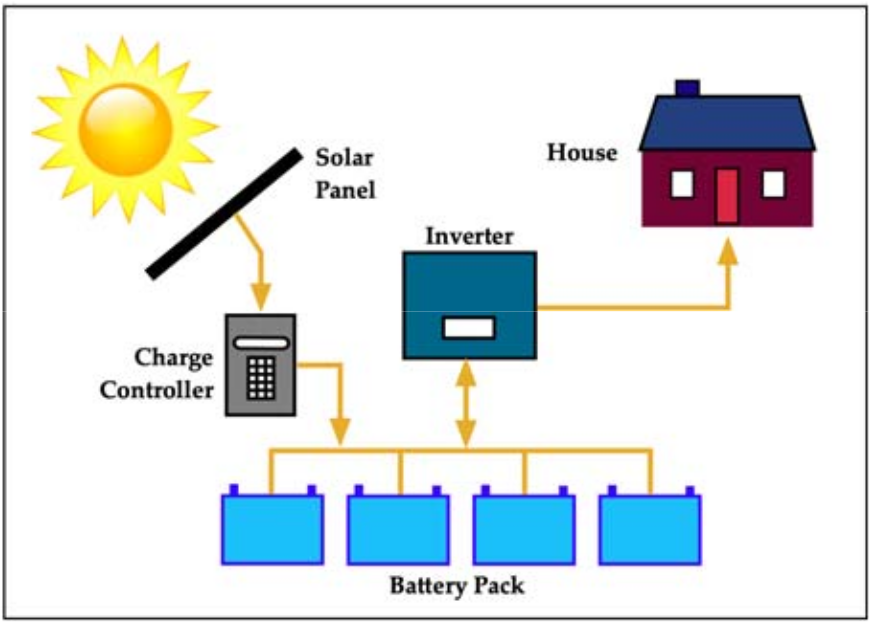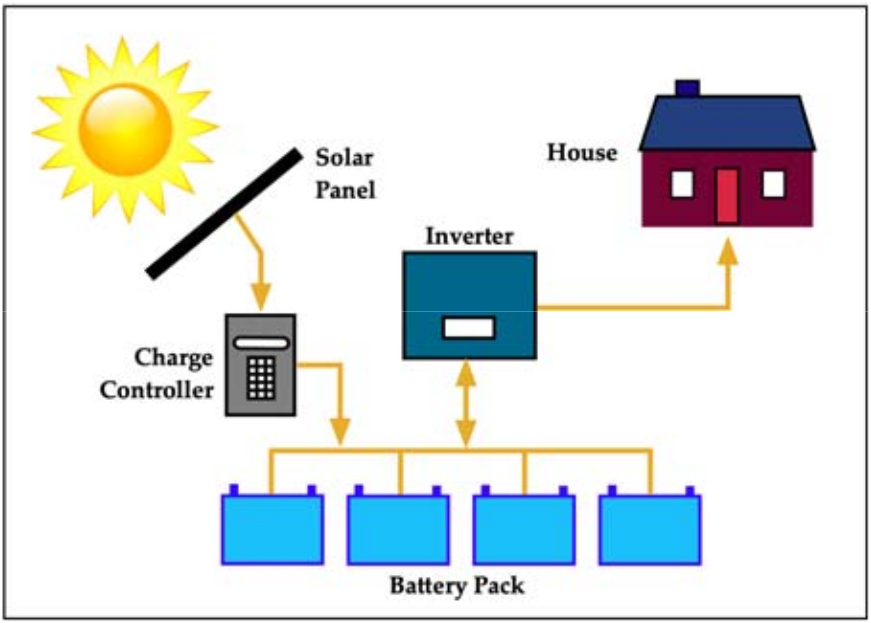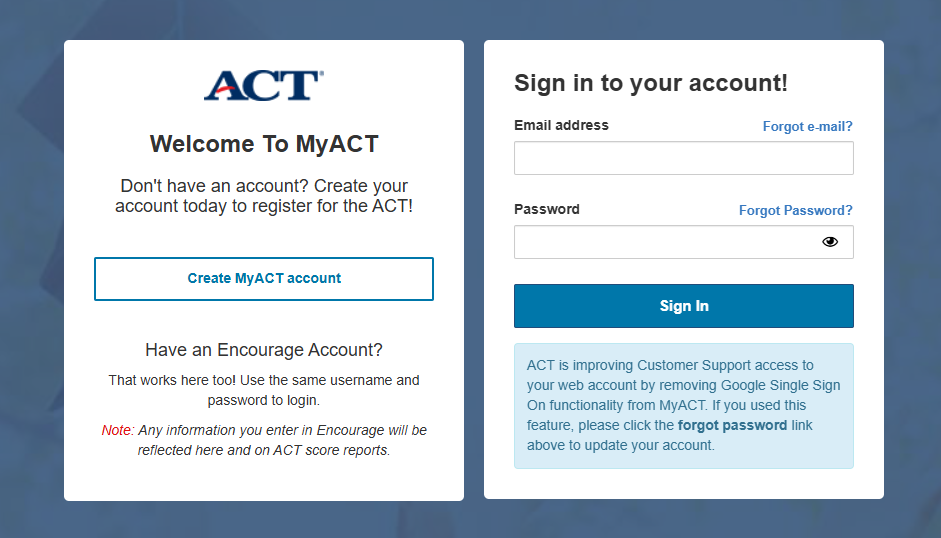文章目录[隐藏]
中文赛题:储存太阳
您的团队正在计划利用太阳能帮助一个偏远地区的1600平方英尺的房子提供电力。您的计划应满足该家庭在夜间和阴天的能量需求。您已经进行了一些研究,发现当您的太阳能电池板产量不足时,您可以从电网(即电力公司)购买电量,或者使用储能系统。由于房子在偏远地区,接入电网的成本非常昂贵,因此您决定不使用电网并投资储能(离网)。
背景: 能量存储系统可以让您获得电能,并将其存储为另一种形式的能量(电池、热能、机械能),然后在需要时使用。这些存储单元的目的是将晴天产生的能量储存起来,以便在太阳能电池板不能产生足够的能量(夜间或云层覆盖)时使用,或者用于存储和转移多余的能量。在使用储能系统的太阳能家庭中,大多数使用某种电池。一些房主只有一个大电池,而另外一些人可能使用“电池组”(连接两个或多个电池)。能量存储可能需要昂贵的成本,因此房主应该选择适合他们情况的系统。图 1 显示了离网能源的简单概念。
 图1: 离网能源系统示意图
图1: 离网能源系统示意图
在选择储能系统时,需要考虑很多准则。以下是一些最常见的决策准则,以及对每种准则最重要的电池规格。
-
要同时为很多的家庭供电,您需要具有高连续额定功率的电池。
-
要为更耗能的设备供电(需要在短时间内提供更多功率),您的电池应该具有较高的瞬时额定功率。
-
要想让储能系统能为您供电更长时间,请寻找具有更高可用容量的电池。
-
如果您想充分利用输入电池的电量,请寻找具有更高往返效率的电池。
其他注意事项适用于电池类型。
-
铅酸(浸没式或密封式)和锂离子电池适用于不同使用级别的全时离网供电。
-
铅酸电池已经存在很长时间,以其低廉的价格和可靠性而闻名。
-
锂离子电池更贵,但无需维护。其他选项是镍镉电池和液流电池。
-
磷酸铁锂 (LFP) 电池(一种锂离子电池)具有最长的使用寿命和最多的循环次数。
-
要获得绝对最高的安全等级(尽管它们都是安全的),请查看 LFP 电池。
要求:
-
考虑您正在规划的 1600 平方英尺的离网住宅。
a. 首先确定您的能源需求需要列出问题列表,从而分析您的太阳能存储需求。讨论您的问题的可能答案范围。为了方便您开始研究,这里提供几个问题:
b. 使用您在第 1.a. 部分中的分析,考虑问题背景中的准则和因素以及您认为重要的任何其他因素,建立数学模型或算法,为您的离网家庭选择“最佳”电池存储系统.
c. 考虑可用的电池存储选项,并使用您的模型为您的离网家庭选择最佳选项。问题陈述末尾的图表提供了几个电池选项(不局限于这几个选项)。讨论您的选择。
- 这个家有多少人会使用能源?
- 家里的哪些物品需要能源,需要多少能源?
- 家里的人什么时候会使用能源?
-
调整并推广您在问题一中所建立的模型,使其能适应个人需求和偏好,可以为任何家庭选择最佳电池存储。讨论您对模型所做的修改。评估您的模型。
-
最近,瑞典的研究人员发现水泥可以用来储存能量[1]。由水泥制成的混凝土用于建造建筑物、人行道、桥梁和无数其他结构。
a. 确定使用水泥电池存储太阳能的一些优点和缺点。描述您如何将水泥用作离网家庭或任何家庭的电池?
b. 确定并讨论您需要的其他信息,以便您对水泥电池的使用进行建模并进行比较,并将其与当前可用的太阳能存储电池进行比较。注意:您不需要创建模型。
-
写一篇一页的非技术新闻稿,描述您的太阳能电池存储方案决策模型。在您的文章中需包含有关水泥电池未来可能性的一些建议。
您的PDF解决方案(不超过 25 页)应包括
- 一页摘要
- 目录
- 完整的解决方案
- 一页新闻稿
- 参考文献
注意: HiMCM 竞赛现在有 25 页的限制。 您提交的所有内容都计入 25 页的限制(摘要表、目录、参考列表和任何附录)。
Glossary:
连续额定功率: 电池在电量耗尽之前可以连续提供的功率(千瓦 (kW) 或安培 (A) )。
储能系统: 可以捕获电力以另一种形式存储,并可随时用来供电的系统
瞬时额定功率: 电池可以在短时间内提供的千瓦 (kW) 或安培 (A) 功率(但不能长期维持)。
使用寿命(电池): 您的电池能正常工作的时长,通过预期的运行年数、预期的吞吐量(kWh使用量)和预期的循环(充电和放电)次数来衡量。
离网:不使用或依赖公共电力供应(或其他公用事业)。
往返效率:你从每一个单位的电池中获得的电量,以百分比来衡量。
可用容量:电池能够储存和供应给您家的电量,以千瓦时 (kWh) 或安培小时 (Ah) 为单位。
英文赛题:Storing the Sun
Your team is helping to plan the use of solar power to provide electricity to a 1600 square-foot home being built in a remote area. You need to plan for enough energy to support the energy requirements of the home at night and on a cloudy day. You have done some research and found that you can either pull energy from the grid (i.e. a power company) when your solar panels aren’t producing enough, or use an energy storage system. As the house is in a remote area, the cost of connecting to the grid is very expensive, so you decide to go off-the-grid and invest in energy storage.
Background: An energy storage system allows you to capture electricity, store it as another form of energy (battery, thermal, mechanical) and then have it available to use when needed. The purpose of these storage units is to store energy produced during sunny daylight hours for use when the solar panels do not produce enough energy for the demand (night or cloud covered), or for storage and transfer of excess energy. Of the solar-powered homes that use an energy storage system, most use some sort of battery. Some homeowners have only one large battery, while others may use a “bank of batteries” (two or more batteries connected). Energy storage can be expensive and so homeowners should choose a system that is appropriate for their situation. Figure 1 shows the general concept of off-the-grid energy.
 Figure 1:Off-the-Grid Energy System
Figure 1:Off-the-Grid Energy System
In choosing an energy storage system there are many criteria to consider. Here are a few of the most common decision criteria, as well as which battery specifications matter most for each criterion.
- To power more of your home at once, you will want a battery with a high continuous power rating.
- To power a more energy-intensive appliance (requiring more power in short bursts), your battery should have a high instantaneous power rating.
- To run your home for a longer amount of time, look for a battery with a higher usable capacity.
- If you want to get the most out of every kilowatt-hour of electricity you put into your battery, look for a battery with a higher round-trip efficiency.
Additional considerations apply for the type of battery.
- Lead-acid (flooded or sealed) and lithium-ion batteries are ideal for a full-time, off-grid supply of different levels of use.
- Lead-acid batteries have been around for a long time and are known for their low prices and reliability.
- Lithium-ion batteries are more expensive, but require no maintenance. Other options are nickel cadmium and flow batteries.
- Look for lithium iron phosphate (LFP) batteries (a type of lithium-ion battery) to get the longest lifetime that you can cycle the most times.
- For the absolute highest safety rating possible (although they are all safe), look to LFP batteries.
Requirements:
-
Consider the 1600 square-foot off-the-grid home you are planning.
a. Analyze your solar-power storage requirements by first making a list of questions to determine your energy needs. Discuss the range of possible answers to your questions. To get you started, here are a few questions:
b. Use your analysis from part 1.a., along with the criteria and considerations from the problem background and any other factors you consider important, to develop a mathematical model or algorithm for choosing the “best” battery storage system for your offthe- grid home.
c. Consider available battery storage options and use your model to choose the best option for your off-the-grid home. The chart at the end of the problem statement provides several, but not all, battery options. Discuss your choice.
- How many people will be using energy in this home?
- What items in the home will need energy and how much energy will they need?
- When will people in the home use energy?
-
Adjust and generalize your model from Requirement 1 so that it is adaptable to individual needs and preferences to choose the best battery storage for any home. Discuss the changes you make to your model. Evaluate your model.
-
Recently, researchers in Sweden discovered that cement could be used to store energy[1]. Concrete, which is made with cement, is used to build buildings, sidewalks, bridges, and countless other structures.
a. Identify some of the advantages and disadvantages of using cement batteries to store solar power. Describe how might you incorporate cement as a battery for your off-the-grid home or for any home?
b. Determine and discuss the additional information you would need in order for you to model and compare the use of cement batteries to currently available batteries for solarpower storage. Note: You are NOT required to create the model.
-
Write a one-page non-technical news article describing your solar power battery storage decision model. Include in your article any recommendations for the future possibilities of a cement battery.
Your PDF solution of no more than 25 total pages should include:
- One-page Summary Sheet.
- Table of Contents.
- Your complete solution.
- One-page Article.
- References list.
Note: The HiMCM Contest now has a 25-page limit. All aspects of your submission count toward the 25-page limit (Summary Sheet, Table of Contents, Reference List and any Appendices).
Glossary:
Continuous Power Rating: the kilowatts (kW) or Amps (A) of power that the battery can provide continuously (until the battery runs out of power).
Energy Storage System: a system that captures electricity, stores it in another form, and then retrieves it for use at a later time.
Instantaneous Power Rating: the kilowatts (kW) or Amps (A) of power that the battery can provide in short bursts (but not sustain over a long period).
Lifetime (of battery): the length of time your battery will continue working which is measured by expected years of operation, expected throughput (kWh of use), and expected number of cycles (charging and discharging).
Off-The-Grid: not using or depending upon public supply of electricity (or other utilities).
Round-Trip Efficiency: the number of units of electricity you’ll get out of a battery for every unit you put into it measured in a percentage.
Usable Capacity: the amount of electricity, in kilowatt-hours (kWh) or Amp-hours (Ah) that a battery is able to store and supply to your home.














